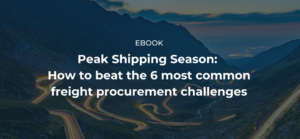[ad_1]
Freight procurement processes have always been noted for their high levels of complexity which increases exponentially during peak shipping season. These busy months demand operational efficiency, agile collaboration, proactive rate management, and a sharp focus on sustainability throughout the transportation management process.
This article by SHIPSTA addresses six of the most common challenges that can surface in peak shipping season, while providing solutions on how to best address them.
1. Pressure to Save Costs
Transportation accounts for a significant amount of total operational costs, consequently becoming a huge target for potential cost savings. However, constantly changing freight market rates can make it difficult for procurement teams to secure the best deals and maintain predictable costs.
To prevent this, it is recommended to move away from standalone data sources and look at leveraging centralised rate management solutions which bring together all your data and provide one sole source of truth. This allows you to turn your data into insights and action and surface the best opportunities by giving you visibility across different pricing options vs the best combination of lanes, modes of transport or other business requirements.
Leveraging the power of an eAuction feature can help you with dynamic negotiations, bringing your qualified carriers or other LSPs into a bidding process, securing your access to the best price and increasing your efficiency.
2. Capacity Shortages & Time Constraints
As demand surges during peak season, the limited capacity of LSPs or unforeseen disruptions can lead to difficulties in providing the needed transportation services in time, causing delays, increased costs or even higher risks or loss. Capacity constraints can turn into missed delivery deadlines and force the company to seek last-minute transportation solutions at higher rates, significantly impacting transportation budgets and overall supply chain costs.
Having fast access to a larger database of LSPs, the ability to pivot to real-time (spot) requests in case of emergencies, as well as instantly connecting with carriers through a centralised and automated platform, while having better visibility on their availability, can be your greatest allies in such situations where time becomes of the essence.
3. Increased Workload and Limited Resources
Even outside peak seasons, transportation procurement is a very heavy process that requires teams to spend countless hours between spreadsheets, emails, and phone calls to ensure smooth sailing. With an even higher growth in demand and workload during peak season, the need for automation and speed has been highlighted more than ever by logistics and procurement teams.
Technology in the logistics sector has evolved to provide tailored solutions for these needs. Such an example is leveraging a specialised freight procurement platform that helps with data-heavy & time-consuming operations, increasing work efficiency and accuracy, while streamlining all communications with your LSPs.
Using such platforms can save up to 70% of the time you would have spent on repetitive and manual tasks. Running tenders, launching RFQs, analysing the outcomes and going through a truly data-driven decision process, can now become a matter of minutes instead of weeks.
4. Complex Freight Landscape
Working with a wide range of carriers, brokers, and other LSPs can complicate the freight procurement process, making it difficult to evaluate and select the most optimal ones as per your business requirements.
However, combinatorics allows you to set your own business rules, flexibly integrate all the relevant criteria based on organisational priorities, like speed, cost, sustainability KPIs, etc. and automatically calculate optimised award scenarios. This will enable you to compare and evaluate at scale multiple suppliers, build detailed reports, and surface the best alternative, especially from a cost perspective, with much less effort.
5. Governance of Sustainability KPIs
With such a large volume of CO2 emissions coming from transportation, governmental and business requirements around sustainability have increased significantly across the years. Even more when we talk about such high shipping volumes like the ones during peak season, meeting these complex regulations and KPIs can be difficult, time-consuming, and costly, in the absence of a proper setup.
The foundation for success is to integrate sustainability criteria from the beginning into your freight procurement strategy and monitor it using dedicated green procurement dashboards. It is important to ensure that your carriers, LSPs or other type of partners are aligned with your expectations in terms of such business requirements, so you can select the best option accordingly.
6. Compliance and Risk Management
Even in a regular, day-to-day context, handling compliance and risk management in freight procurement becomes an exceedingly difficult and sensitive task. With all complexity increasing exponentially in peak shipping seasons, meeting transportation & other government regulations, as well as business compliance standards, can become difficult and leave room for exposures.
Integrating your end-to-end freight procurement processes, managing LSPs, contracts, award of business and relevant documents within a dedicated platform helps you ensure that compliance is well up to company standards and will prepare a solid base for auditing when the time comes.
In uncertain times, allocating money to technology cannot always seem like an easy decision, but it quickly becomes one when ROI and further cost savings top by more than 10x the price.
Take a closer look at SHIPSTA to see how its platform and services can help you both during and outside the peak shipping seasons. To uncover more ways to win this peak shipping season, read the complete e-book here.
[ad_2]
Source link













